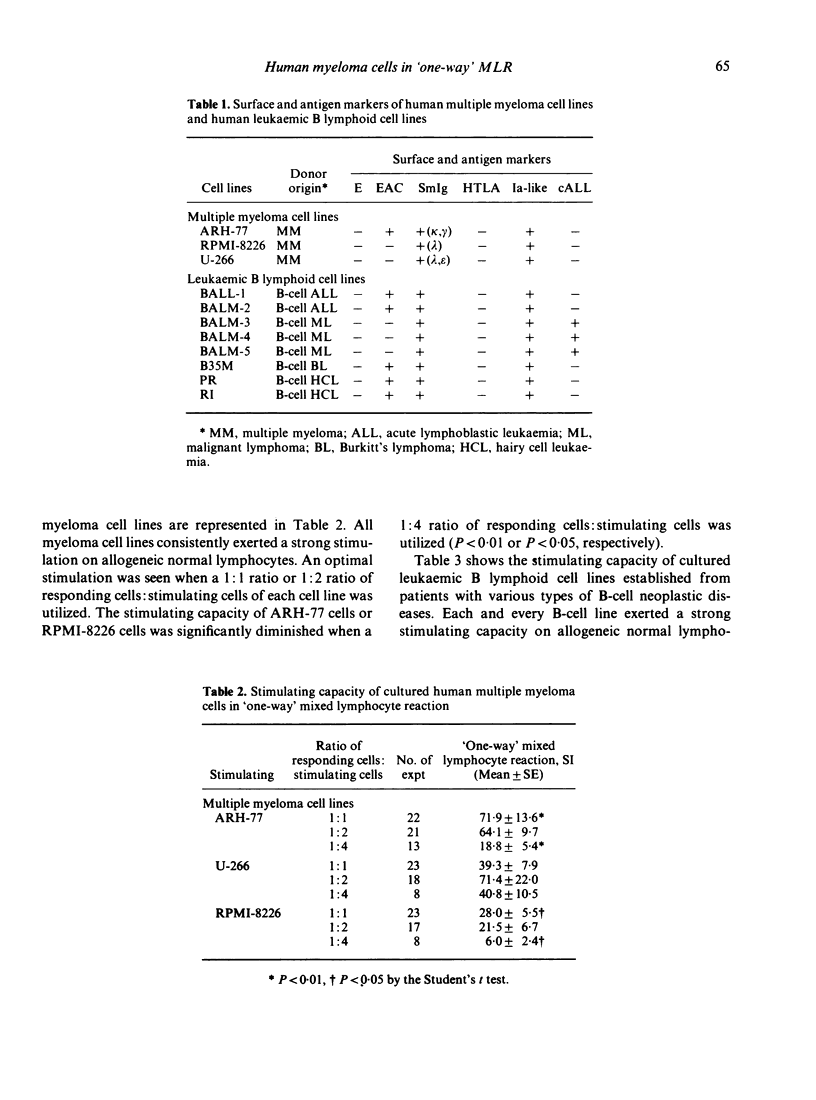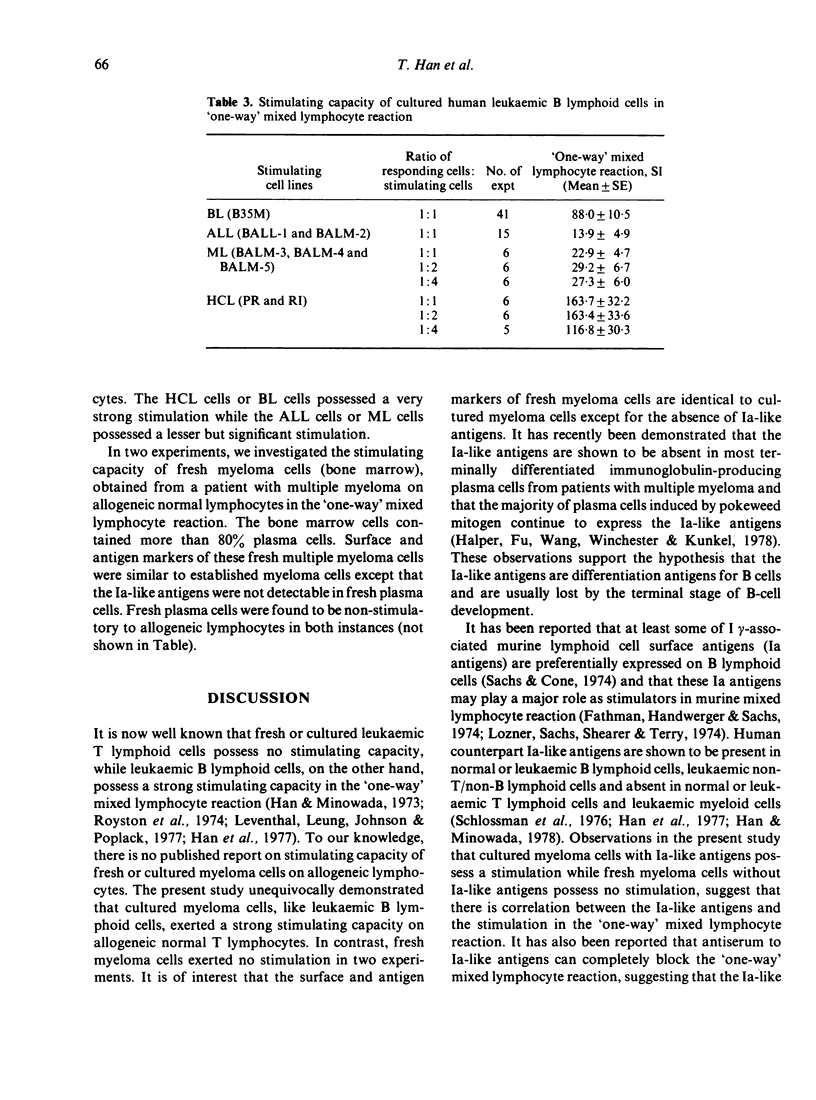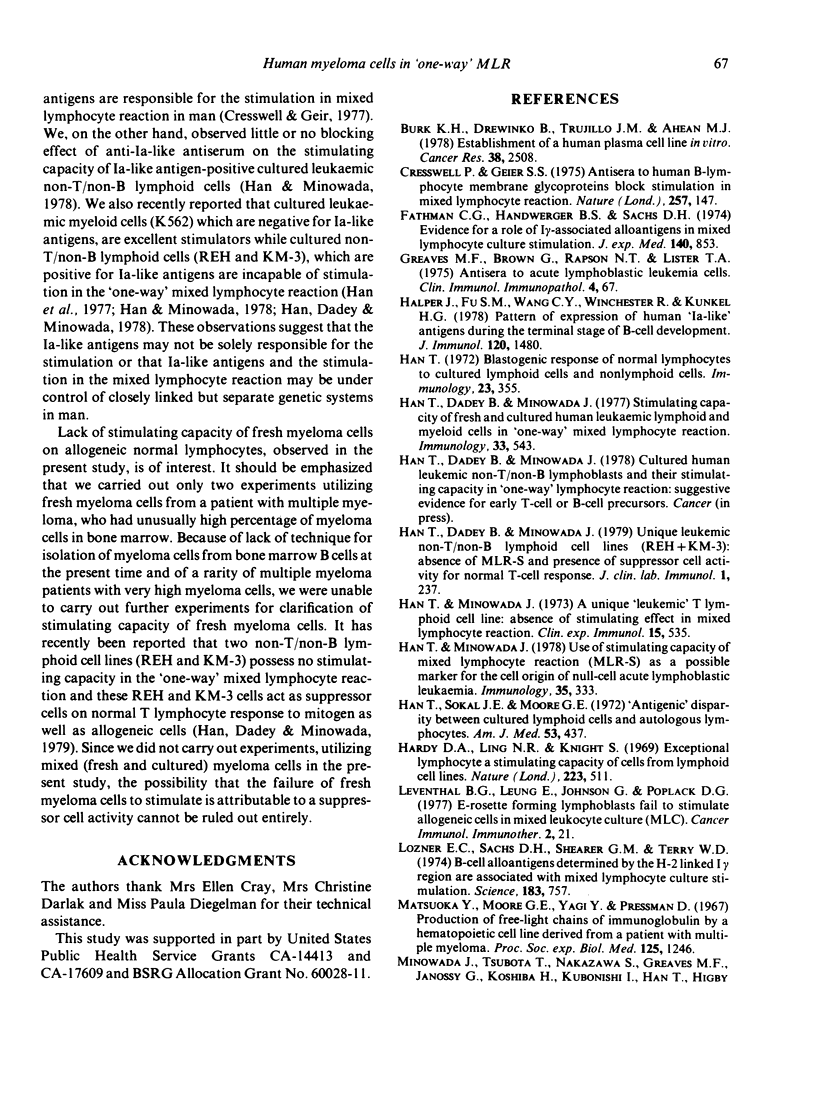Abstract
Cultured human myeloma cells (ARH-77, RPMI-8226 and U-266), like leukaemic B lymphoid cells, consistently exerted a strong stimulating capacity on allogeneic lymphocytes in the 'one-way' mixed lymphocyte reaction. An optimal stimulation was seen when a 1:1 ratio or 1:2 ratio of responding cell:stimulating cells of each cell line was utilized. The stimulating capacity of ARH-77 or RPMI-8226 cells was significantly diminished when a 1:4 ratio of responding cells:stimulating cells was utilized. Fresh bone marrow cells containing more than 80% plasma cells from a patient with multiple myeloma, on the other hand, failed to exert the stimulating capacity on two occasions. The striking difference between cultured myeloma cells and fresh plasma cells is that the Ia-like antigen is present on cultured myeloma cells, and this antigen is absent on fresh plasma cells. The relationship between the Ia-like antigen and the stimulating capacity in 'one-way' mixed lymphocyte reaction is discussed.
Full text
PDF





Selected References
These references are in PubMed. This may not be the complete list of references from this article.
- Burk K. H., Drewinko B., Turjillo J. M., Ahearn M. J. Establishment of a human plasma cell line in vitro. Cancer Res. 1978 Aug;38(8):2508–2513. [PubMed] [Google Scholar]
- Cresswell P., Geler S. S. Antisera to human B-lymphocyte membrane glycoproteins block stimulation in mixed lymphocyte culture. Nature. 1975 Sep 11;257(5522):147–149. doi: 10.1038/257147a0. [DOI] [PubMed] [Google Scholar]
- Fathman C. G., Handwerger B. S., Sachs D. H. Evidence for a role of Ir-associated alloantigens in mixed lymphocyte culture stimulation. J Exp Med. 1974 Sep 1;140(3):853–858. doi: 10.1084/jem.140.3.853. [DOI] [PMC free article] [PubMed] [Google Scholar]
- Greaves M. F., Brown G., Rapson N. T., Lister T. A. Antisera to acute lymphoblastic leukemia cells. Clin Immunol Immunopathol. 1975 May;4(1):67–84. doi: 10.1016/0090-1229(75)90041-0. [DOI] [PubMed] [Google Scholar]
- Halper J., Fu S. M., Wang C. Y., Winchester R., Kunkel H. G. Patterns of expression of human "Ia-like" antigens during the terminal stages of B cell development. J Immunol. 1978 May;120(5):1480–1484. [PubMed] [Google Scholar]
- Han T. Blastogenic response of normal lymphocytes to cultured lymphoid cells and non-lymphoid neoplastic cells. Immunology. 1972 Sep;23(3):355–359. [PMC free article] [PubMed] [Google Scholar]
- Han T., Dadey B., Minowada J. Stimulating capacity of fresh and cultured human leukaemic lymphoid and myeloid cells in 'one-way' mixed lymphocyte reaction. Immunology. 1977 Oct;33(4):543–551. [PMC free article] [PubMed] [Google Scholar]
- Han T., Dadey B., Minowada J. Unique leukemic non-T/non-B lymphoid cell lines (REH and KM-3): absence of MLR-S and presence of suppressor cell activity for normal T-cell response. J Clin Lab Immunol. 1978 Nov;1(3):237–243. [PubMed] [Google Scholar]
- Han T., Minowada J. A unique 'leukaemic' T lymphoid cell line: absence of stimulating effect in mixed lymphocyte reaction. Lack of MLR-S in leukaemic T lymphoid cells. Clin Exp Immunol. 1973 Dec;15(4):535–541. [PMC free article] [PubMed] [Google Scholar]
- Han T., Sokal J. E., Moore G. E. "Antigenic" disparity between cultured lymphoid cells and autologous lymphocytes. Am J Med. 1972 Oct;53(4):437–445. doi: 10.1016/0002-9343(72)90139-8. [DOI] [PubMed] [Google Scholar]
- Hardy D. A., Ling N. R., Knight S. C. Exceptional lymphocyte stimulating capacity of cells from lymphoid cell lines. Nature. 1969 Aug 2;223(5205):511–512. doi: 10.1038/223511a0. [DOI] [PubMed] [Google Scholar]
- Lozner E. C., Sachs D. H., Shearer G. M., Terry W. D. B-cell alloantigens determined by the H-2 linked Ir region are associated with mixed lymphocyte culture stimulation. Science. 1974 Feb 22;183(4126):757–759. doi: 10.1126/science.183.4126.757. [DOI] [PubMed] [Google Scholar]
- Matsuoka Y., Moore G. E., Yagi Y., Pressman D. Production of free light chains of immunoglobulin by a hematopoietic cell line derived from a patient with multiple myeloma. Proc Soc Exp Biol Med. 1967 Aug-Sep;125(4):1246–1250. doi: 10.3181/00379727-125-32327. [DOI] [PubMed] [Google Scholar]
- Nilsson K., Bennich H., Johansson S. G., Pontén J. Established immunoglobulin producing myeloma (IgE) and lymphoblastoid (IgG) cell lines from an IgE myeloma patient. Clin Exp Immunol. 1970 Oct;7(4):477–489. [PMC free article] [PubMed] [Google Scholar]
- Pauly J. L., Minowada J., Han T., Moore G. E. Disparity of mixed lymphocyte reactivity to cultured cells of human T and B lymphoid lines. J Natl Cancer Inst. 1975 Mar;54(3):557–562. [PubMed] [Google Scholar]
- Pauly J. L., Sokal J. E., Han T. Whole-blood culture technique for functional studies of lymphocyte reactivity to mitogens, antigens, and homologous lymphocytes. J Lab Clin Med. 1973 Sep;82(3):500–512. [PubMed] [Google Scholar]
- Royston I., Graze P. R., Pitts R. B. Failure of cultured human T-cell lymphoid lines to stimulate in mixed leukocyte culture. J Natl Cancer Inst. 1974 Aug;53(2):361–367. doi: 10.1093/jnci/53.2.361. [DOI] [PubMed] [Google Scholar]
- Sachs D. H., Cone J. L. A mouse B-cell alloantigen determined by gene(s) linked to the major histocompatibility complex. J Exp Med. 1973 Dec 1;138(6):1289–1304. doi: 10.1084/jem.138.6.1289. [DOI] [PMC free article] [PubMed] [Google Scholar]
- Saxon A., Stevens R. H., Quan S. G., Golde D. W. Immunologic characterization of hairy cell leukemias in continuous culture. J Immunol. 1978 Mar;120(3):777–782. [PubMed] [Google Scholar]
- Tsubota T., Minowada J., Nakazawa S., Sinks L. F., Han T., Higby R. J., Pressman D. Correlation of surface markers of cells of human lymphatic leukemias with disease type. J Natl Cancer Inst. 1977 Sep;59(3):845–850. doi: 10.1093/jnci/59.3.845. [DOI] [PubMed] [Google Scholar]


